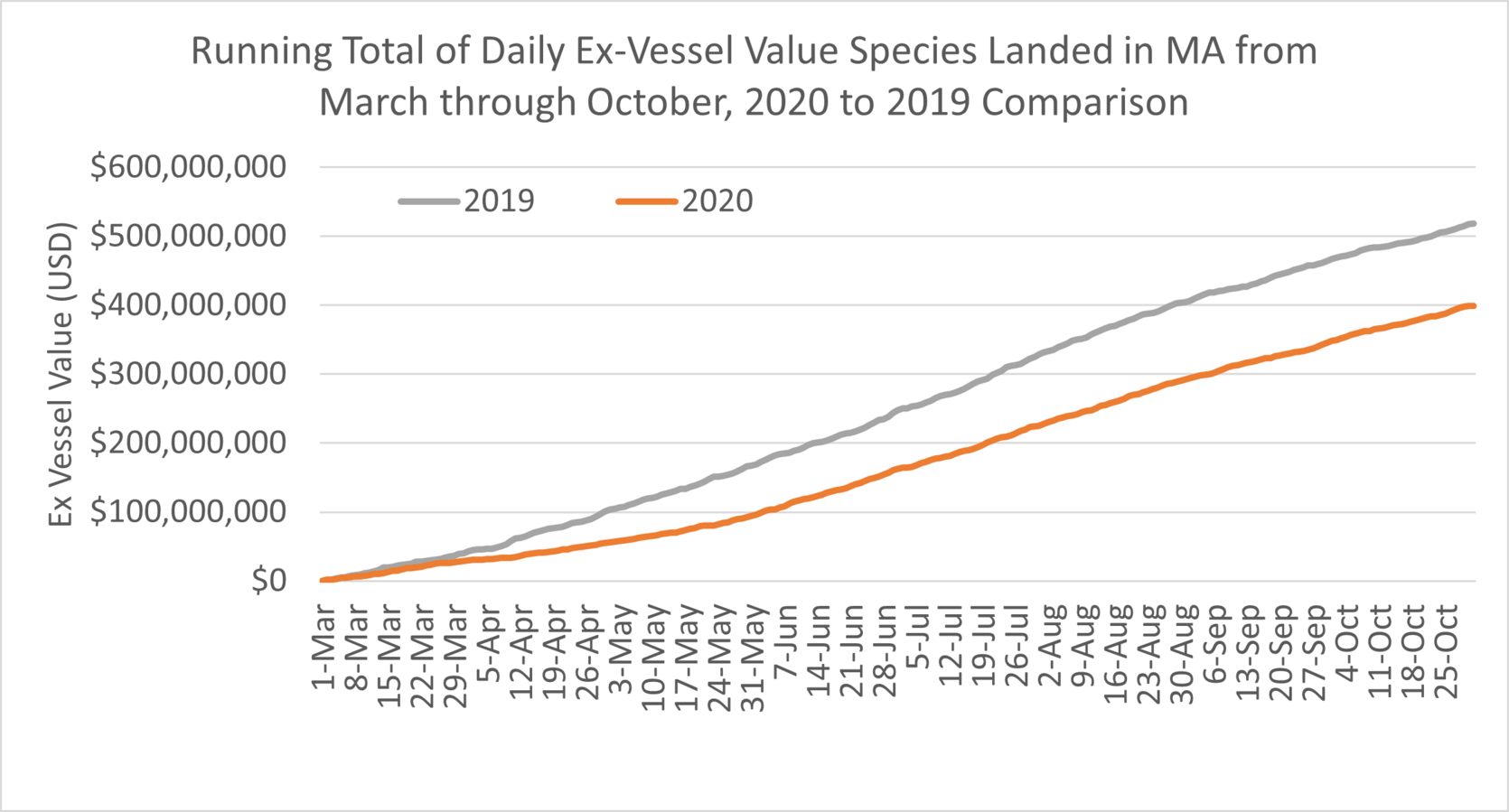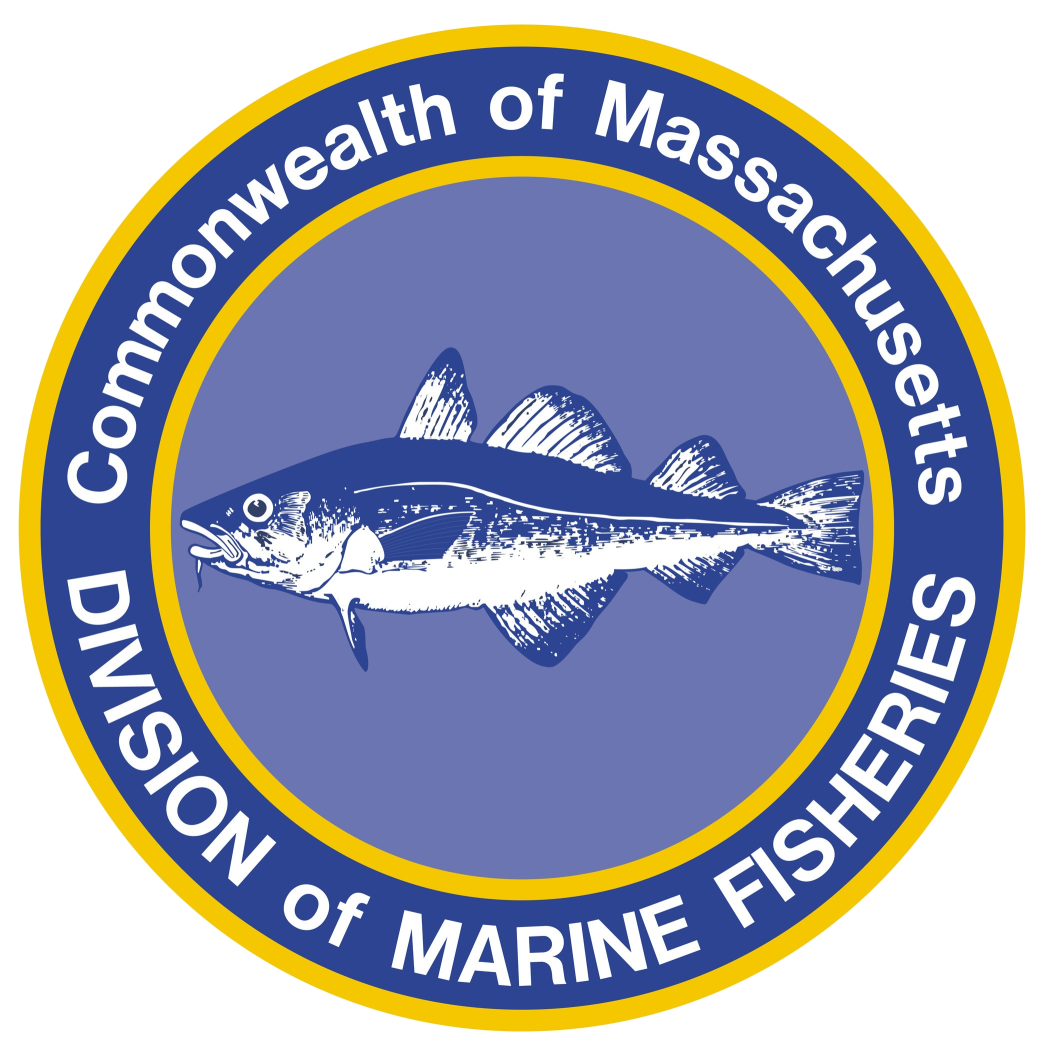- Division of Marine Fisheries

This past spring, DMF responded rapidly to the availability of federal funding through the CARES Act to provide relief to the beleaguered fishing and seafood industry. With critical input from industry-based working groups, Massachusetts became the first state in the nation to distribute CARES relief funding to fishermen and seafood processors, with all payments issued by mid-November. The federal government recently announced another $300 million that will be distributed to states in early 2021 for fishing and seafood relief. DMF plans to reconvene the working groups to aid in the distribution of this next round of congressionally approved funding.
On May 7, 2020, the Secretary of Commerce announced the allocation of $300 million in fisheries assistance funding provided by Section 12005 of the Coronavirus Aid, Relief, and Economic Security Act (CARES Act) for those seafood and fishing industry sectors negatively affected by the COVID-19 pandemic. Approximately $28 million of this funding was allocated by NOAA Fisheries to the Commonwealth of Massachusetts, the third-highest allocation in the country. The allocation to states was based on past revenues from four identified fishing sectors: seafood processing, commercial fishing, aquaculture, and recreational for-hire fishing. In Massachusetts, the contribution from each sector was estimated as 51.2% seafood processing, 45.2% commercial fishing, 2.1% aquaculture, and 1.5% for-hire fishing. The Division of Marine Fisheries (DMF) was tasked with distributing these relief funds to the four identified fishing sectors.
Information gathered during the first months of the COVID-19 emergency demonstrated that economic assistance was sorely needed. The ex-vessel value of commercial and aquaculture landings across species during March and April had declined over 30% as compared to the prior five-year average. Landings data collected from March through October would later reveal a total loss of over $121 million, or over 23%, paid to harvesters as compared to 2019 (see figure), with losses occurring in nearly all fisheries. Species that are served primarily in restaurants, including oysters, lobsters, and bluefin tuna faced even greater reductions in value. The oyster industry suffered the greatest overall percentage loss with over 85% documented in the month of April and roughly 50% from March through October as compared to 2019.
While similar loss calculations were not immediately possible for seafood processors and for-hire fishing businesses, social distancing mandates had easily observed impacts: seafood processors took a major hit from the loss of the restaurant market, while for-hire fishing businesses faced complete shutdowns or strict restrictions on their operations. Data subsequently collected from charter and head boat businesses that were eligible for funding revealed average revenue losses or more than 60% during March through June.
Accordingly, DMF set an ambitious goal of distributing the CARES Act relief to all sectors within a matter of months. DMF put together an internal team of DMF employees to make up the “Massachusetts CARES Act Fisheries Relief Team” to develop and implement a relief program for an industry with over 9,000 participants. The first step was to craft a spending plan for submittal to the Atlantic States Marine Fisheries Commission (ASMFC) for approval by NOAA Fisheries.
The Team felt strongly that the relief program and spending plan could only be developed with significant industry participation. DMF formed an eleven-member industry-based advisory panel and held its first virtual meeting on June 1, 2020. Following that meeting, working groups were created for each of the four sectors. Each working group was assigned two DMF employees to serve as co-chairs and included industry representatives of diverse characteristics. By mid-June 2020, nine virtual meetings had been held with the sector working groups, and within five weeks of the announcement by the Secretary of Commerce, DMF submitted a spending plan to the federal government. In July, Massachusetts became the first state to have an approved spending plan for this critical program.
To be eligible for participation in the relief program, applicants were required to self-certify to several CARES Act stipulations: that they had suffered a 35% revenue loss caused by COVID-19 relative to a previous five-year period specified for each sector, and that relief from this program plus other forms of COVID-19 pandemic-related aid and traditional fishing revenue would not total more than their normal revenue. In addition, DMF implemented residency and age restrictions as required by the Act. Criteria were developed for each sector to further refine the pool of eligible permit holders and to tier payments based on such elements as vessel activity and size in the for-hire fleet, ex-vessel sales for the commercial and aquaculture sectors, and minimum seafood sales and number of employees for seafood processors.
Applications were developed based on the specific criteria approved for each sector and all permit holders were direct mailed an application packet that indicted their potential eligibility. Initial eligibility determinations were based on data submitted to DMF by the permit holders, through either normal reporting processes or pre-application surveys. Applicants were given a deadline for submitting an application, followed by an appeals period. At the conclusion of the appeal period (once the final pool of eligible applicants was known), payment values were determined according to the tiering metrics. Payments for most sectors were processed through the ASMFC on behalf of the Commonwealth. The exception to this was the for-hire head boat sector which the Commonwealth expedited direct payments to and requested reimbursement from ASMFC.
Across all four sectors, MA DMF approved more than 950 applications for this relief program. In the for-hire sector, $1,000,000 was shared across 34 head boats (totaling $416,000) and 72 charter boats (totaling $584,000); payments ranged from $1,432 to $22,912. The $1,152,000 designated for the aquaculture relief program was shared between 170 eligible applications; payments ranged from $495 to $15,830. The $13,779,788 designated for seafood processors/wholesale dealers was shared between 113 eligible businesses; payments ranged from $44,740 to $357,917. In the commercial fishing sector, over 560 applications were accepted into the program; payments ranged from $6,353 to $38,117, totaling $11,822,468 for this sector.
The Massachusetts fishing industry attributable to these four sectors is valued at approximately $1.4 billion annually. Although the $28 million of CARES Act fisheries relief allocated to the state will only cover a portion of the total losses faced by local fisheries as a result of the COVID-19 pandemic, the Commonwealth was fortunate to receive the funds and is proud to have been able to provide relief to local businesses in an expedient manner.
In addition to the CARES Act fisheries relief, other relief programs are providing support to the fishing industry. The United States Department of Agriculture’s Seafood Trade Relief Program is offering fishermen with relief payments to mitigate impacts of foreign tariffs affecting seafood value. For each eligible species, participants will receive payment per pound of landings in 2019 (for example, the per pound payment is 50 cents for lobster, 20 cents for squid, 15 cents for flounder, and 13 cents for tuna). Based on DMF’s calculations, this could result in over $15 million in direct payments to fishermen.
USDA is also providing molluscan shellfish farmers with a 10% payment based off their 2019 revenues. In Massachusetts, this could result in about $3 million in direct payments to growers because 2019 aquaculture sales by farmers to wholesale dealers were approximately $30 million.
Two other small-scale plans are underway for oyster relief. The first is a program funded by The Nature Conservancy to buy surplus oysters and place them on established or permitted oyster “reefs” for ecological services. These purchases would be limited to those in nearby locations of the reefs. Secondly, a private grant organized by Sea Grant and Barnstable County will support the purchase of “oversized oysters” to go into value-added foods, such as chowders, for those in need.
By Maggie Nazarenus, Grants Coordinator
